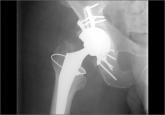Article

Total Hip Arthroplasty for Posttraumatic Osteoarthritis of the Hip Fares Worse Than THA for Primary Osteoarthritis
- Author:
- Khurana S
- Nobel TB
- Merkow JS
- Walsh M
- Egol KA
We conducted a study to evaluate differences between patients who had total hip arthroplasty (THA) for posttraumatic osteoarthritis (OA) and...
